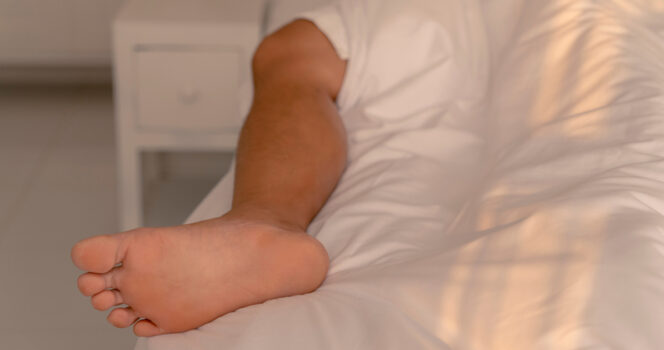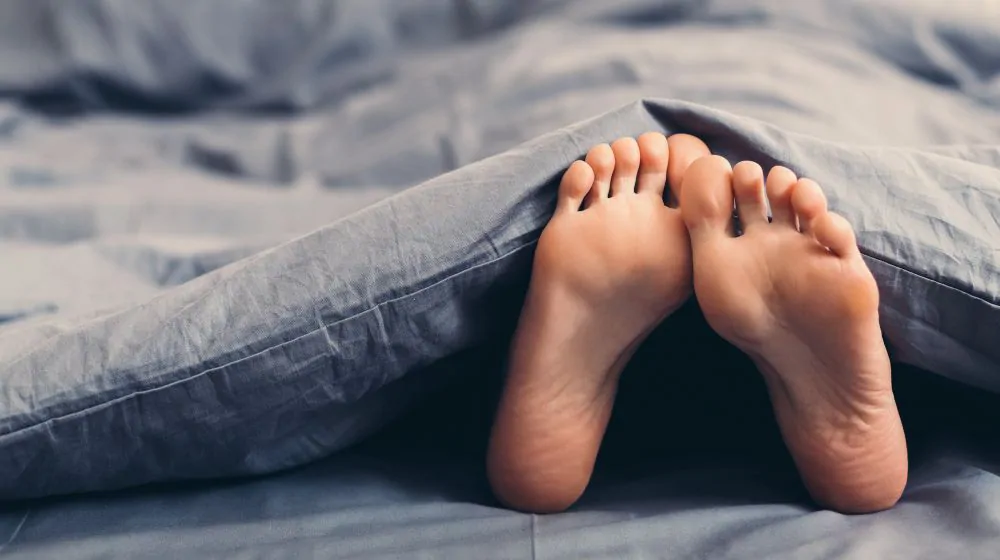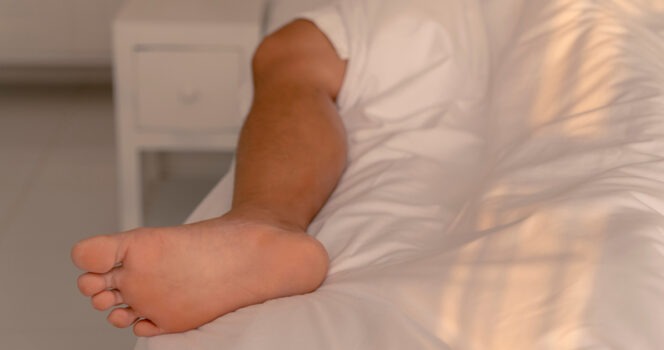Many people do it instinctively: when the room feels too warm or sleep feels out of reach, one foot quietly slips out from under the blanket. It’s a habit so common and natural that most of us never stop to think about why it feels comforting — yet sleep researchers say this simple action may play a meaningful role in helping the body ease into rest.
While it might seem like nothing more than a quirky bedtime preference, the “one foot out” method actually taps into your body’s built-in temperature and sleep-regulation system. And science offers an explanation for why it can make falling asleep easier.
How Temperature Shapes Your Ability to Fall Asleep

Human sleep is closely tied to daily temperature rhythms. As evening approaches, your internal clock signals the body to gradually lower its core temperature — a shift that helps prepare you for sleep.
According to the Sleep Foundation, this cooling starts roughly two hours before bedtime and continues throughout the night, reaching its lowest point in the early morning. This natural temperature drop is one of the key signals the brain uses to transition into deeper stages of sleep.
To support this cooling process, your body sends warm blood away from the core and toward the skin’s surface, especially to the hands and feet. When these extremities are exposed to cooler air, they help release excess heat efficiently, allowing the core temperature to fall faster.
In other words, your foot sticking out from under the covers isn’t random — it’s part of an instinctive cooling mechanism that supports your body’s sleep cycle.
Why the Feet Play a Special Role in Thermoregulation

Feet — along with hands — contain a large number of unique blood vessels called arteriovenous anastomoses. These vessels allow warm blood to bypass capillaries and move directly toward the skin’s surface. This makes the feet exceptionally effective at helping your body release heat.
Because blankets trap warmth, your body may start feeling slightly overheated as you try to fall asleep. Letting just one foot escape allows cool air to circulate around a highly efficient “heat vent,” helping you reach a more comfortable temperature without removing the blanket entirely.
Sleep researcher Natalie Dautovitch, speaking to New York Magazine, noted that this cooling reflex is likely the reason many people naturally stretch a foot outside the sheets. It’s the body’s way of fine-tuning temperature to achieve optimal rest.
Falling Asleep Faster: What the Research Shows

Scientists sometimes measure how easily a person can fall asleep using something called the distal-to-proximal gradient (DPG). This compares the temperature of the extremities — hands and feet — with the temperature closer to the body’s core.
A higher DPG means the extremities are releasing heat efficiently and the body’s internal temperature is dropping — a pattern strongly associated with faster sleep onset.
In a reported study published in the Journal of Physiology, people with warmer hands and feet fell asleep significantly more quickly than those whose extremities stayed cooler. This suggests that warming the hands and feet and then releasing heat may be a helpful strategy for easing into sleep.
By placing one foot outside the blanket, you allow heat to escape rapidly, potentially increasing DPG and helping your system transition smoothly toward sleep.
Small Habit, Big Impact: How One Foot Can Help You Cool Down
Think of the “foot-out” method as a built-in thermostat that requires no effort and adjusts automatically. A single foot outside the covers provides:
-
Gentle cooling without changing the room temperature
-
A stable environment where the rest of the body stays warm and comfortable
-
A natural way to support circadian rhythms
-
A quick response when you feel slightly too warm under thick blankets
It’s a simple, passive trick that many people use without ever consciously deciding to.
Other Ways to Support Your Body’s Cooling Before Sleep
While letting one foot breathe is one of the easiest cooling tools, pairing it with other habits can make your entire bedtime routine more effective:
Take a warm bath one to two hours before bed
Warming your skin encourages heat to dissipate later, helping the body cool down once you’re out of the tub.
Keep the bedroom slightly cool
Many sleep experts recommend a nighttime temperature between 65°F and 68°F (18°C–20°C), although personal comfort varies.
Warm your feet first if they tend to get cold
Cold extremities can keep the body from releasing heat efficiently. Gently warming your feet before bed — using socks, a warm foot bath, or a heating pad — can help, and you can remove layers later if needed.
Use breathable bedding materials
Cotton, bamboo, or linen helps regulate temperature better than thick synthetic fabrics.
When the “One Foot Out” Method May Not Feel Comfortable
Although many people benefit from gradual cooling, the strategy is not ideal for everyone. Some individuals naturally have colder feet, experience poor circulation, or live in already cool climates. For them, exposing a foot may cause discomfort rather than relaxation.
People with circulation-related conditions, such as Raynaud’s phenomenon, may prefer consistent warmth instead of allowing sudden cooling.
Children, older adults, or individuals sensitive to cold may sleep better with their feet fully covered. The key is to pay attention to your body’s signals and adjust accordingly.
The Simple Science Behind a Common Habit
What makes the “one foot out” habit so interesting is how universal it is — and how accurately it reflects what sleep researchers know about thermoregulation. Without thinking about it, many people allow their bodies to self-adjust, helping heat dissipate so sleep can come more easily.
The next time you find yourself struggling to fall asleep under a warm blanket, try letting a foot slip into the cool night air. This small adjustment can work with your body’s natural rhythms — not against them — to help you settle into rest more comfortably.
Sometimes, the secret to better sleep really is as simple as giving your feet a little room to breathe.
